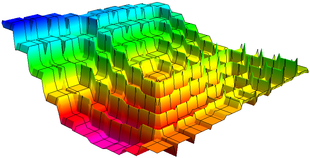10-327/Homework Assignment 3: Difference between revisions
No edit summary |
|||
| Line 11: | Line 11: | ||
===Due date=== |
===Due date=== |
||
This assignment is due at the end of class on |
This assignment is due at the end of class on Monday, October 18, 2010. |
||
===Suggestions for Good Deeds=== |
===Suggestions for Good Deeds=== |
||
Revision as of 13:48, 13 October 2010
| ||||||||||||||||||||||||||||||||||||||||||||||||||||||||||||
Reading
Read sections 19, 20, 21, and 23 in Munkres' textbook (Topology, 2nd edition). Remember that reading math isn't like reading a novel! If you read a novel and miss a few details most likely you'll still understand the novel. But if you miss a few details in a math text, often you'll miss everything that follows. So reading math takes reading and rereading and rerereading and a lot of thought about what you've read. Also, preread sections 24 and 26, just to get a feel for the future.
Doing
Solve the following problems from Munkres' book, though submit only the underlined ones: Problems 6, 7 on page 118, and problems 3, 4, 5, 6, 8, 9, 10 on pages 126-128.
Class Photo
Identify yourself in the 10-327/Class Photo page!
Due date
This assignment is due at the end of class on Monday, October 18, 2010.
Suggestions for Good Deeds
Annotate our Monday videos (starting with Video: ![]() Topology-100927) in a manner similar to (say)
Topology-100927) in a manner similar to (say) ![]() AKT-090910-1, and/or add links to the blackboard shots, in a manner similar to
AKT-090910-1, and/or add links to the blackboard shots, in a manner similar to ![]() Alekseev-1006-1. Also, make constructive suggestions to me, Dror and / or the videographer, Qian (Sindy) Li, on how to improve the videos and / or the software used to display them. Note that "constructive" means also, "something that can be implemented relatively easily in the real worlds, given limited resources".
Alekseev-1006-1. Also, make constructive suggestions to me, Dror and / or the videographer, Qian (Sindy) Li, on how to improve the videos and / or the software used to display them. Note that "constructive" means also, "something that can be implemented relatively easily in the real worlds, given limited resources".
| Dror's notes above / Student's notes below |
Discussion
- Question about HW3 8(b). I still don't understand why the uniform topology on is strictly finer than the product topology. If you find any open nbd in uniform topology of any point in only finitely many component are in the form of because the sequence has infinitely many 's. Can't I just choose these multiply by infinitely many copies of in the product topology? -Kai
- Good thought, but there is something wrong in your logic. This though remains your assignment to do, so what I'll write may sound a bit cryptic: Note that in the uniform topology, the constraint applies also to the 's. Drorbn 18:13, 12 October 2010 (EDT)
- But once you get the intersection with , those constraints should disappear?
- No. Drorbn 21:18, 12 October 2010 (EDT)
- But once you get the intersection with , those constraints should disappear?
- Good thought, but there is something wrong in your logic. This though remains your assignment to do, so what I'll write may sound a bit cryptic: Note that in the uniform topology, the constraint applies also to the 's. Drorbn 18:13, 12 October 2010 (EDT)
- Hi Dror, 8(b)(c) are really difficult and they involve several different concepts about infinity. Do you think you can go through them in class? Different concepts of infinity seem to be really intricate and I don't know how to argue properly. It seems it is true either way evenly philosophical in my point of view. Although its my homework assignment to do I still want to learn how to argue in questions like that. I hope you can teach us for learning purposes rather than marks. Maybe some other smart guys probably have already figured that out but I am not as smart. But this doesn't change the fact that I want to learn. Thanks. -KaiXwbdsb 23:56, 12 October 2010 (EDT)
- I really have been spending a whole day on this assignment but still nothing comes to my mind how to prove box topology is strictly finer than l^2 topology. Dror could you possibly explain on this for a little bit please?-Kai Xwbdsb 00:18, 13 October 2010 (EDT)
- For a sequence to eventually end with 0's. does it mean that it can only have finitely many non zeros terms? How about for a sequence with infinitely many 0's does it mean that the sequence can only have finitely many non-0 terms? -Kai

![{\displaystyle [0,1]}](https://wikimedia.org/api/rest_v1/media/math/render/svg/738f7d23bb2d9642bab520020873cccbef49768d)







